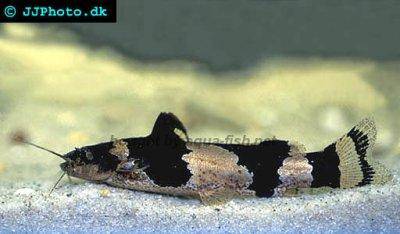Bumblebee catfish - Microglanis iheringi
Scientific name: Microglanis iheringi
Common name: Bumblebee catfish
Family: Pseudopimelodidae
Usual size in fish tanks: 6 - 7 cm (2.36 - 2.76 inch)
014
Recommended pH range: 6.4 - 7.5
Recommended water hardness: 9 - 19°N (160.71 - 339.29ppm)
0°C 32°F30°C 86°F
Recommended temperature range: 22 - 25 °C (71.6 - 77°F)
The way how these fish reproduce: Spawning
Where the species comes from: South America
Temperament to its own species: peaceful
Temperament toward other fish species: peaceful
Usual place in the tank: Bottom levels
Origin
South America; Bumblebee catfish are found in the waterways of Venezuela.
Lifespan
The expected life span for Microglanis iheringi is 4 years.
Short description
The Bumblebee catfish can easily be recognised by its black and yellow banding that runs along the whole length of the body. They make great tank mates for most species of fish due to their peaceful temperament but after lights out they will hunt for food making very small fish and fry prime targets to satisfy their needs.
Microglanis iheringi are very peaceful, even with members of their own species. They are good tank mates in a community set up but do require high water quality. Add rocks or wood to provide hiding places and a few bushy plants like Amazon swords or Java ferns.
They are primarily a nocturnal species so will hide away a lot in the daylight hours, they become a lot more active after lights out but can be tempted to come out for food in the daytime.
Food and feeding
Bumblebee catfish are definitely not fussy eaters and will accept all foods offered. Use a quality flake and catfish pellets for their staple diet. They will also relish a treat of brine shrimp. The Bumblebee catfish is a bottom feeder so make sure that they do get their share of the food if kept with other species that inhabit the higher levels of the aquarium, feeding after lights out should help with this problem as they are more active than their tank mates at this time of day.
Sexing
When viewed from above females tend to have a plumper body shape compared to the males but this is not always an accurate guide to sexing these fish.
Breeding
Provide caves or tunnels in the tank and use dim lighting. Try to place the tank in a quiet corner so that the fish do not get disturbed by human traffic. The parent fish can be prepared for the spawning period by offering them rich meaty foods to condition them and raising the water temperature should also help. Performing a cool water change a few days after the increase could trigger the spawning. The eggs will be laid in the piping and guarded by the male. When the fry are free swimming, they can be fed on crushed flake or newly hatched brine shrimp.
Picture
Bought by aqua-fish.net from jjphoto.dk.

